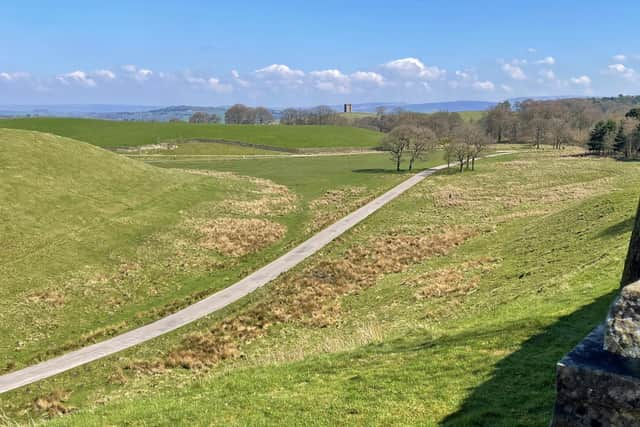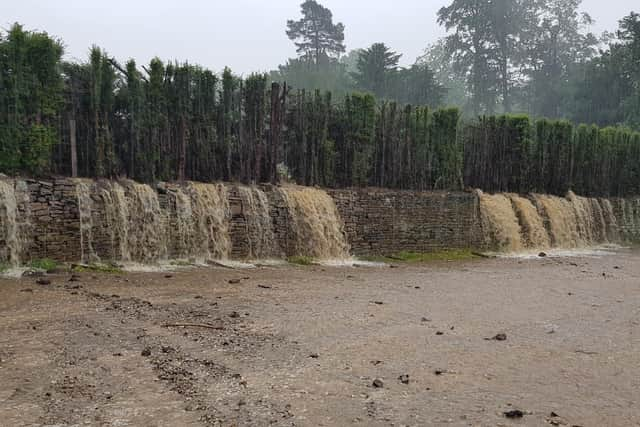Plans for giant new car park at Peak District National Trust estate provoke flood of objections
This article contains affiliate links. We may earn a small commission on items purchased through this article, but that does not affect our editorial judgement.
and live on Freeview channel 276
The heritage charity has submitted a planning application to the Peak District National Park Authority (PDNPA) for the creation of 1,065 spaces on what is described as moorland to the west of the Lyme Park estate, which some estimates suggest would make it the biggest car park in the national park.
The plans would see the current Swine Ground parking area, historically the final approach to Lyme Hall from the west, restored to a garden design last seen in the 1940s.
Advertisement
Hide AdAdvertisement
Hide AdProponents say that would have the added benefit of helping to avoid a repeat of the flooding which caused around £250,000-worth of damage to the estate in 2019 – although planning documents suggest the process began internally in 2015.


A National Trust spokesperson said: “Climate change and extreme weather events increasingly puts places like Lyme at risk. The proposed infrastructure project aims to help us adapt to the future by improving resilience to climate change, restoring the historic views of the house and upgrading our facilities.
“The proposed project aims to maintain the current number of visitors who arrive by car, and not increase car parking spaces. We’ll continue to work with individuals and partners to find more sustainable ways that people can visit Lyme now and in the future.”
One of the key factors in the plans is that the new asphalt parking areas would be usable in all weather conditions. The current land configuration only allows 395 permanent hard-surfaced spaces, with more than 600 others considered overflow spaces on garden or parkland.
Advertisement
Hide AdAdvertisement
Hide AdThe National Trust argues that the changes would allow the estate to reliably accommodate more visitors, improving traffic flow and thereby reducing tailbacks on surrounding roads, while also removing cars from some of the more scenic viewpoints immediately around the house.


Restoration of the Swine Ground would also allow include opening up the small stream which currently runs beneath it, making it easier to direct watercourses during periods of heavy rainfall.
Accompanying work would expand and resurface the Knott car park, which lies further out into the park, create a new path network and build facilities for a shuttle bus service between the car parks and the house.
The spokesperson said: “We’re in desperate need to upgrade our facilities to ensure that the 300,000 visitors we welcome to National Trust Lyme each year have a great experience with us, while lessening the impact of busy days on our neighbours.”
Advertisement
Hide AdAdvertisement
Hide AdNot everyone is convinced by the plans so far, however, with the public consultation drawing a deluge of objections ahead of the deadline on Tuesday, May 9, and an online petition already garnering more than 500 signatures.


While most have welcomed the plan to move parking from the Swine Ground, those opposing the plan say it will do little to address existing traffic access problems, spoil other views of the protected national park landscape and create new traffic hazards for pedestrians and cyclists using the park.
Other complaints argue the plans would entail the loss of green space and agricultural land, and fly in the face of the National Trust’s commitment to reach net zero greenhouse emissions by 2030, and PDNPA’s ambition to reduce car use.
An objection from Buxton resident Cameron Murray notes: “The concept of ‘induced demand’ is well established and accepted amongst transport experts, and although the actions of the Department for Transport, National Highways, and many local highway authorities don’t indicate they accept the theory, recently the Welsh Government has publicly acknowledged it and are adjusting their policies intentions accordingly.
Advertisement
Hide AdAdvertisement
Hide Ad“Put basically - if one increases the ease and attractiveness of driving to a destination, those who are privileged enough to drive will drive, and this will induce an increase in motor traffic on surrounding roads.


“If the aim is to reduce the environmental impact of visitor travel to the park, the National Trust should be adopting a ‘decide and provide’ approach to transport planning rather than a predict and provide approach, since you will get the traffic you design for.”
Instead, campaigners are calling for measures to reduce car traffic such as park and ride schemes and better promotion of public transport active travel infrastructure serving the area around the park.
There is vocal opposition from the local cycling community in particular, such as blogger Anthony Sheridan, who said: “These plans go against key aims of both the Peak District National Park and National Trust to combat climate change, provide sustainable access to the countryside and reduce the impact of cars on our precious green spaces.
Advertisement
Hide AdAdvertisement
Hide Ad“31 per cent of households in Greater Manchester have no access to a car, yet the plans do nothing to make visiting Lyme easier for these people.”
He added: “The proposed location of this super-sized new car park makes no sense for anyone. It would destroy peaceful walking and cycling routes into the park, be a permanent visual blight from the surrounding National Park moorland, and require all visitors to walk half a mile up steep hills, or use a minibus to access Lyme Hall.”
Further information on the proposals can be found at nationaltrust.org.uk/visit/cheshire-greater-manchester/lyme/building-on-history---projects-at-lyme.
For the full planning application (NP/CEC/0323/0337) and a form to submit comments, go to https://portal.peakdistrict.gov.uk/03230337 or see https://bit.ly/3L9dKoQ for the public petition.